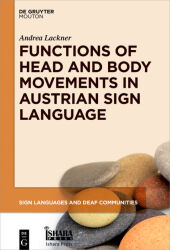 Neuerscheinungen 2017Stand: 2020-02-01 |
Schnellsuche
ISBN/Stichwort/Autor
|
Herderstraße 10
10625 Berlin
Tel.: 030 315 714 16
Fax 030 315 714 14
info@buchspektrum.de |

Andrea Lackner
Functions of Head and Body Movements in Austrian Sign Language
2017. XXIV, 261 S. 80 b/w ill., 5 b/w tbl. 230 mm
Verlag/Jahr: DE GRUYTER; DE GRUYTER MOUTON 2017
ISBN: 1-501-51633-7 (1501516337)
Neue ISBN: 978-1-501-51633-7 (9781501516337)
Preis und Lieferzeit: Bitte klicken
Over the past decades, the field of sign language linguistics has expanded considerably. Recent research on sign languages includes a wide range of subdomains such as reference grammars, theoretical linguistics, psycho- and neurolinguistics, sociolinguistics, and applied studies on sign languages and Deaf communities. The SLDC series is concerned with the study of sign languages in a comprehensive way, covering various theoretical, experimental, and applied dimensions of sign language research and their relationship to Deaf communities around the world. The series provides a multidisciplinary platform for innovative and outstanding research in sign language linguistics and aims at linking the study of sign languages to current trends in modern linguistics, such as new experimental and theoretical investigations, the importance of language endangerment, the impact of technological developments on data collection and Deaf education, and the broadening geographical scope of typological sign language studies, especially in terms of research on non-Western sign languages and Deaf communities.
Research on nonmanual elements - or ´nonmanuals´ - in sign languages has focused on both the possible functions and the occurrence (frequency and form) of these elements in recent years. As a matter of fact, research on nonmanuals is still a quite uncharted territory in Austrian Sign Language (ÖGS) today, which has also initiated the study given.
In order to identify head and body movements in ÖGS, these nonmanuals were determined and analyzed functionally via a new user-oriented methodology. Getting feedback of multiple native signers was a main part of this method. Accordingly, you will find the findings of this study in this volume: various functions such as negation, assertion, interrogativity, conditionality, and many more can be expressed nonmanually. Brand new insights into sign language research are given, as well as astonishing results: even (epistemic) modality can be expressed by particular head and body movements.
Andrea Lackner, Karl-Franzens-Universität Graz, Austria


